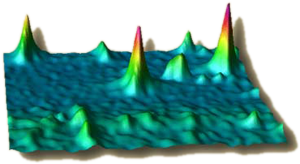
Del Mar Photonics - Ti:Sapphire CW and femtosecond lasers for optofluidics
Customer inquiry:
we are looking for a CW dye laser for single molecule spectroscopy. We need linewidth < 1 MHz, longterm stability better than 100 kHz/second and a very good pointing stability.

Related Bibliography
"Optical Detection and Spectroscopy of Single Molecules in a Solid," by W. E.
Moerner and L. Kador, Phys. Rev. Lett. 62, 2535 (1989). This is the first report
of single-molecule detection and spectroscopy in condensed phases.
"Fluorescence Spectroscropy and Spectral Diffusion of Single Impurity Molecules
in a Crystal," by W.P. Ambrose and W. E. Moerner, Nature 349, 225 (1991).
"Spectroscopy of Single Impurity Molecules in Solids," by W. E. Moerner and Th.
Basche', Angew. Chem. 105, 537 (1993); Angew. Chem. Int. Ed. Engl. 32, 457
(1993).
"Examining Nanoenvironments in Solids on the Scale of a Single, Isolated
Impurity Molecule," by W. E. Moerner, Science 265, 46 (1994).
"High-Resolution Optical Spectroscopy of Single Molecules in Solids, by W. E.
Moerner, in "Single Molecules and Atoms," Special Issue of Accounts of Chemical
Research, December 1996.
"Fundamentals of Single-Molecule Spectroscopy in Solids," Chapter 1 of Single
Molecule Optical Detection, Imaging, and Spectroscopy, T. Basche, W. E. Moerner,
M. Orrit, and U. P. Wild, eds. (Verlag Chemie, Munich, 1997).
W. E. Moerner, "Those Blinking Single Molecules," Science 277, 1059 (1997).
W. E. Moerner and M. Orrit, "Illuminating Single Molecules in Condensed Matter,"
Science 283, 1670-1676 (1999).
B. Lounis and W. E. Moerner, "Single Photons on Demand from a Single Molecule at
Room Temperature," Nature 407, 491-493 (2000).
H. Sosa, E. J. G. Peterman, W. E. Moerner, and L. S. B. Goldstein, "ADP-Induced
Rocking of the Kinesin Motor Domain Revealed by Single-Molecule Fluorescence
Polarization Microscopy," Nature Structural Biology 8, 540-544 (2001).
W. E. Moerner, "Thirteen Years of Single-Molecule Spectroscopy in Physical
Chemistry and Biophysics," in Single-Molecule Spectroscopy: Nobel Conference
Lectures, R. Rigler, M. Orrit, Th. Basche, Editors, Springer Series in Chemical
Physics, Volume 67 (Springer-Verlag, Heidelberg, 2001), pp. 32-61.
W. E. Moerner, "A Dozen Years of Single-Molecule Spectroscopy in Physics,
Chemistry, and Biophysics," J. Phys. Chem. B 106, 910-927 (2002).
W. E. Moerner, "Single-Molecule Optical Spectroscopy of Autofluorescent
Proteins," J. Chem. Phys. 117, 10925 (2002).
W. E. Moerner and D. P. Fromm, "Methods of Single-Molecule Fluorescence
Spectroscopy and Microscopy," Rev. Sci. Instrum. 74, 3597-3619 (2003).
E. J. G. Peterman, H. Sosa, and W. E. Moerner, “Single-Molecule Fluorescence
Spectroscopy and Microscopy of Biomolecular Motors,” invited review, Ann. Rev.
Phys. Chem. 55, 79-96 (2004).
P. J. Schuck, D. P. Fromm, A. Sundaramurthy, G. S. Kino, and W. E. Moerner,
“Improving the Mismatch Between Light and Nanoscale Objects with Gold Bowtie
Nanoantennas,” Phys. Rev. Lett. 94, 017402 (2005).
K. A. Willets, S. Y. Nishimura, P. J. Schuck, R. J. Twieg, and W. E. Moerner,
"Nonlinear Optical Chromophores as Nanoscale Emitters for Single-Molecule
Spectroscopy," invited review, Accounts Chem. Res. 38, 549-556 (2005)
S. Y. Kim, Z. Gitai, A. Kinkhabwala, L. Shapiro, and W. E. Moerner, “Single
Molecules of the Bacterial Actin MreB Undergo Directed Treadmilling Motion in
Caulobacter crescentus,” Proc. Nat. Acad. Sci. (USA) 103, 10929-10934 (2006)..
A. E. Cohen and W. E. Moerner, “Suppressing Brownian Motion of Individual
Biomolecules in Solution,” Proc. Nat. Acad. Sci. (USA) 103, 4362-4365 (2006).
W. E. Moerner, “New Directions in Single-Molecule Imaging and Analysis,” Invited
Perspective, Proc. Nat. Acad. Sci. (USA) 104, 12596-12602 (2007).
J. S. Biteen, M. A. Thompson, N. K. Tselentis, G. R.Bowman, L. Shapiro, W. E.
Moerner, “Superresolution Imaging in Live Caulobacter Crescentus Cells Using
Photoswitchable EYFP,” Nature Meth. 5, 947-949 (2008).
W. E. Moerner, “Single-Molecule Optical Spectroscopy and Imaging: From Early
Steps to Recent Advances,” in Single Molecule Spectroscopy in Chemistry, Physics
and Biology: Nobel Symposium 138, Springer Series in Chemical Physics Vol. 96,
A. Gräslund, R. Rigler, J. Widengren, Eds. ( Springer-Verlag, Berlin, 2009).
A. Kinkhabwala, Z. Yu, S. Fan, Y. Avlasevich, K. Müllen, and W. E. Moerner,
“Large Single-Molecule Fluorescence Enhancements Produced by a Bowtie
Nanoantenna,” Nature Photonics 3, 654-657 (2009)..
S. J. Lord, H.-L. D. Lee, and W. E. Moerner, “Single-Molecule Spectroscopy and
Imaging of Biomolecules in Living Cells," Anal. Chem. 82, 2192-2203 (2010) .
CW single-frequency ring Dye laser DYE-SF-077 -
request a
quote
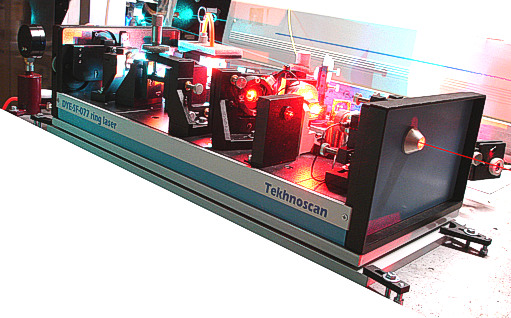
Frequency-stabilized CW single-frequency ring Dye laser, model DYE-SF-077, is a
further development of model DYE-SF-07. It now includes a system of frequency
stabilization on the basis of a thermo-stabilized interferometer and a fast
electronic driver.
Laser DYE-SF-077 features exceptionally narrow generation line width,
which
amounts to less than 100 kHz. DYE-SF-077 sets new standard for generation
line width of commercial lasers. Prior to this model, the narrowest line-width
of commercial dye lasers was as broad as 500 kHz - 1 MHz. It is necessary to
note that the 100-kHz line-width is achieved in DYE-SF-077 without the use of an
acousto-optical modulator, which, as a rule, complicates the design and
introduces additional losses. A specially designed ultra-fast PZT is used for
efficient suppression of radiation frequency fluctuations in a broad frequency
range
570-700 nm, output > 1.5 W (10 W pump), linewidth < 100 kHz rms, frequency drift
< 30 MHz/hour, smooth scanning 6/20 GHz.
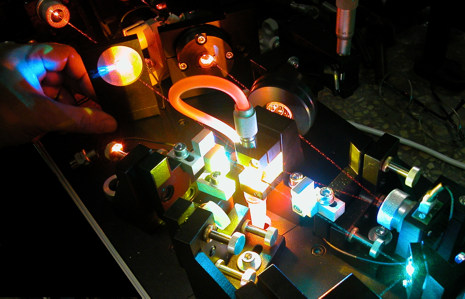
The DYE-SF-077 laser cavity has horizontal orientation, the optical mounts of
the cavity elements are attached to a rigid base plate, which is further
stabilized by a volumetric framework with three invar rods underneath.
Additional passive stability of the position of cavity elements is provided by
the vibration isolating design of the laser base.
Dye laser DYE-SF-077 is the first representative of the new generation of dye lasers that offer to the user virtually the same level of convenience and simplicity of operation as with a solid-state tunable laser. As a result we are able to offer an option of combined configuration of DYE-SF-077 with Ti:Sapphire laser.
Laser DYE-SF-077 may be equipped with a USB compatible interface to remotely scan the generation line of the laser and to perform multi-channel data acquisition. Laser DYE-SF-077 also may be shipped together with an atom cell and a system for reduction of long-term generation line drift. Besides, laser DYE-SF-077 in combination with highly-efficient resonant frequency doubler FD-SF-07 delivers several hundreds milliwatts of narrow-band UV radiation within the 285–350-nm range.
CW single-frequency ring Dye laser DYE-SF-077 - request a quote
Specifications:
| Wavelength range | 570-620 nm 620-700 nm |
| Output | > 1 W at 6 W pump >1.5W at 10W pump |
| Linewidth | < 100 kHz rms1 |
| Frequency drift | < 30 MHz/hour |
| Smooth scanning | > 6 GHz3 |
| Spatial mode | TEM00 |
| Polarization | horizontal |
1. relative to the reference cavity
2. < 1 MHz/hour with frequency stabilization to an atomic/molecular line
(option)
3. up to 20 / 40 GHz (option)
Options:
1. 20 / 40 GHz smooth scanning;
2. 285-350 nm wavelength range with Resonant Frequency Doubler FD-SF-07
3. Absolute Frequency stabilization to an atomic/molecular line
4. + Ti:Sapphire laser (linewidth < 5 kHz) in the same Laser head
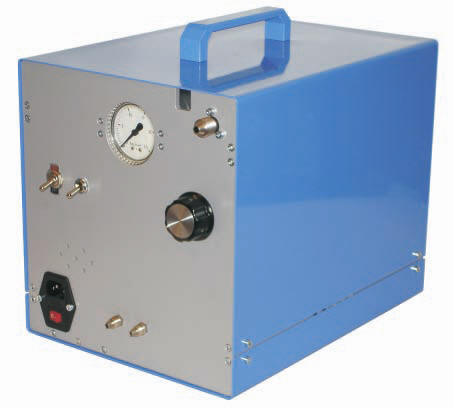
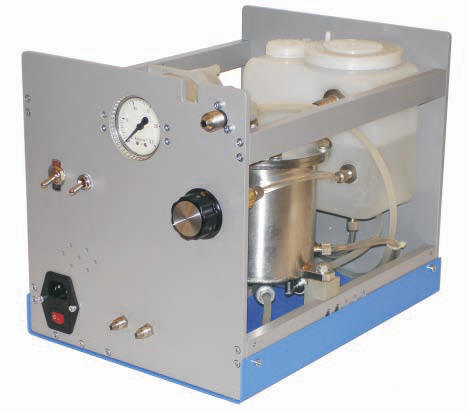
Dye Circulation System
CW single-frequency ring Dye laser DYE-SF-077 (Standard quotation) - request a quote
Actively frequency-stabilized, continuous-wave, single-frequency
ring Dye laser, model DYE-SF-077
Unique DYE-SF-077 laser has more narrow linewidth for Dye lasers on the present
market. DYE-SF-077 laser has super-narrow linewidth (< 70 kHz) and unique Auto
Re-lock function which is extremely useful in a work with frequency stabilized
laser.
Installation of the T&D Scan high resolution Laser Spectrometer based on broadly tunable CW laser at the Drexel University

Del Mar Photonics, Inc.
4119 Twilight Ridge
San Diego, CA 92130
tel: (858) 876-3133
fax: (858) 630-2376
Skype: delmarphotonics
sales@dmphotonics.com
www.twitter.com/TiSapphire